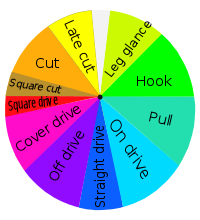Run scoring
- For more details on Run, see Run (cricket).

To score a run, a striker must run to the opposite end of the pitch, while his non-striking partner runs to his end. To register a run, both runners must touch the ground behind the popping crease with either their bats or their bodies (the batsmen carry their bats as they run). If the striker hits the ball well enough, the batsmen may double back to score two or more runs. This is known as running between wickets. However, no rule requires the batsman to run upon striking the ball. The decision to attempt a run is made by the batsman who has the better view of the ball's position and is communicated by a system of calls: "yes", "no" or "wait". If the batsmen score an odd number of runs, then they will have swapped ends and their roles as striker and non-striker will be reversed for the next ball, unless the most recent ball marks the end of an over.
If a fielder knocks the bails off the stumps with the ball while no part of the batsman is grounded behind the popping crease, the nearer batsman is run out. (For this purpose, "batsman" includes the bat so long as he is holding it.)
If the ball reaches the boundary, then runs are automatically scored. A ball that goes over the boundary on the full (without touching the ground) automatically scores six runs; a ball that reaches the boundary after having touched the ground automatically scores four runs. These are scored instead of any runs the batsmen may have already run, and they return to the ends at which they started, except in the unlikely event that the batsmen have already scored more runs than they would receive for the boundary.
Extras
- For more details on extras, see Extra (cricket).
Every run scored by the batsmen contributes to the team's total. A team's total also includes a number of runs which are unaccredited to any batsmen. These runs are known as extras, apart from in Australia where they are also called sundries. Extras consist of byes, leg byes, no balls, wides and penalty runs. Byes and leg byes can be scored if the batsman misses making contact with bat and ball; while no-balls and wides are types of fouls committed by the bowler. For serious infractions such as tampering with the ball, deliberate time-wasting, and damaging the pitch, the umpires may award penalty extras to the opposition: in each case five runs. Five penalty runs are also awarded if a fielder uses anything other than his body to field the ball, or if the ball hits an object—a protective helmet, for example—left on the field by the fielding team. A team need not be batting in order to receive penalty extras.
No comments:
Post a Comment